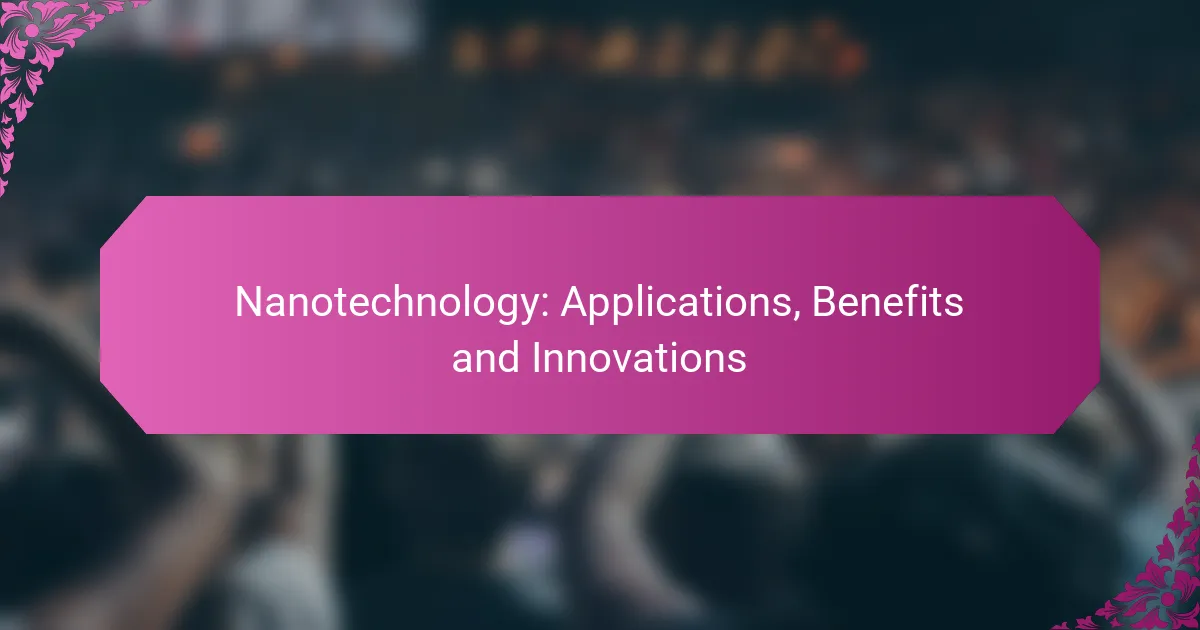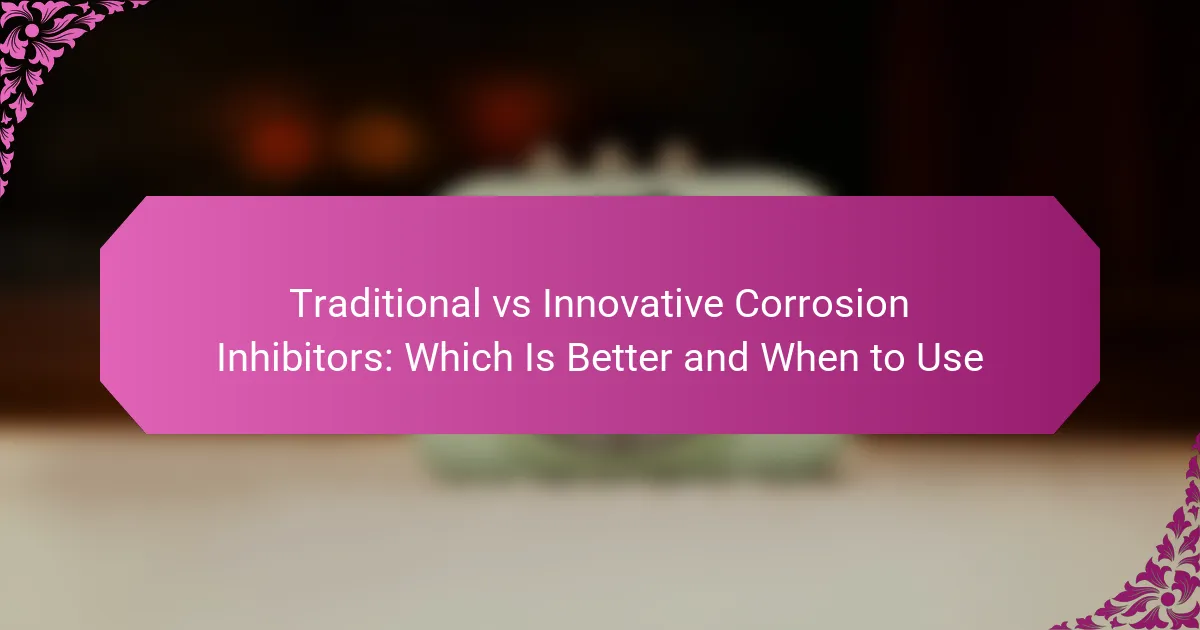Nanotechnology is a groundbreaking field that manipulates materials at the atomic and molecular scale, leading to significant advancements across various sectors. Its applications in medicine, electronics, and environmental science are revolutionizing treatment methods, enhancing device performance, and improving ecological sustainability. By harnessing the unique properties of nanomaterials, we can achieve unprecedented efficiency and effectiveness in numerous processes, ultimately benefiting society as a whole.
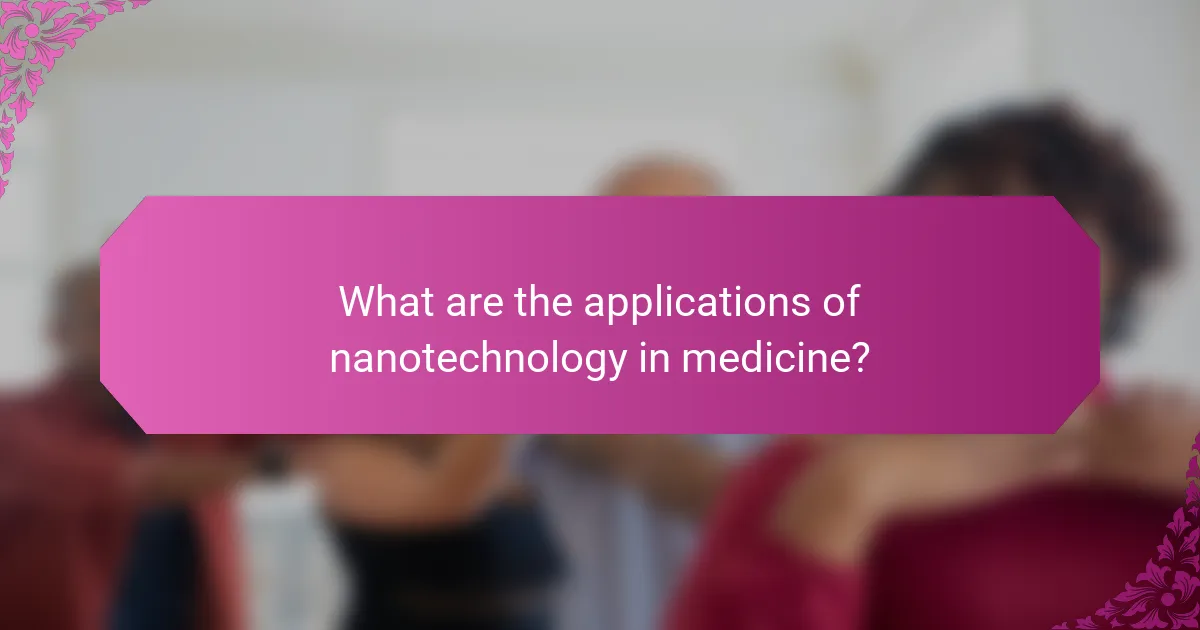
What are the applications of nanotechnology in medicine?
Nanotechnology has transformative applications in medicine, enhancing treatment efficacy and patient outcomes. Key areas include drug delivery, diagnostic imaging, tissue engineering, antimicrobial coatings, and cancer treatment.
Drug delivery systems
Nanotechnology improves drug delivery systems by enabling targeted and controlled release of medications. Nanoparticles can encapsulate drugs, allowing them to be delivered directly to diseased cells while minimizing side effects on healthy tissues.
For instance, liposomes and dendrimers are commonly used nanocarriers that enhance the solubility and bioavailability of poorly soluble drugs. This targeted approach can significantly increase the therapeutic effect while reducing the required dosage.
Diagnostic imaging enhancements
Nanotechnology enhances diagnostic imaging through the development of contrast agents that improve the visibility of tissues and organs. Nanoparticles can provide higher resolution images and allow for earlier detection of diseases.
Quantum dots and gold nanoparticles are examples of nanomaterials used in imaging techniques such as MRI and CT scans. These advancements can lead to more accurate diagnoses and better monitoring of disease progression.
Tissue engineering
In tissue engineering, nanotechnology facilitates the creation of scaffolds that mimic the natural extracellular matrix, promoting cell growth and tissue regeneration. These nanostructured materials can enhance cell adhesion, proliferation, and differentiation.
For example, nanofibers made from biodegradable polymers can be used to create scaffolds for skin, bone, or cartilage repair. This approach holds promise for regenerative medicine and improving recovery outcomes.
Antimicrobial coatings
Nanotechnology is utilized to develop antimicrobial coatings that can be applied to medical devices and surfaces to reduce infection rates. These coatings often incorporate silver or copper nanoparticles, which exhibit strong antimicrobial properties.
Such coatings can be particularly effective in hospitals, where the risk of infections is high. By preventing bacterial colonization on devices like catheters and implants, these innovations can enhance patient safety and reduce healthcare costs.
Nanoparticles for cancer treatment
Nanoparticles play a crucial role in cancer treatment by enabling targeted therapy that minimizes damage to healthy cells. These particles can deliver chemotherapeutic agents directly to tumor sites, improving treatment efficacy and reducing side effects.
For instance, iron oxide nanoparticles can be used in magnetic hyperthermia, where localized heating destroys cancer cells while sparing surrounding tissue. This method represents a promising avenue for more effective cancer therapies.
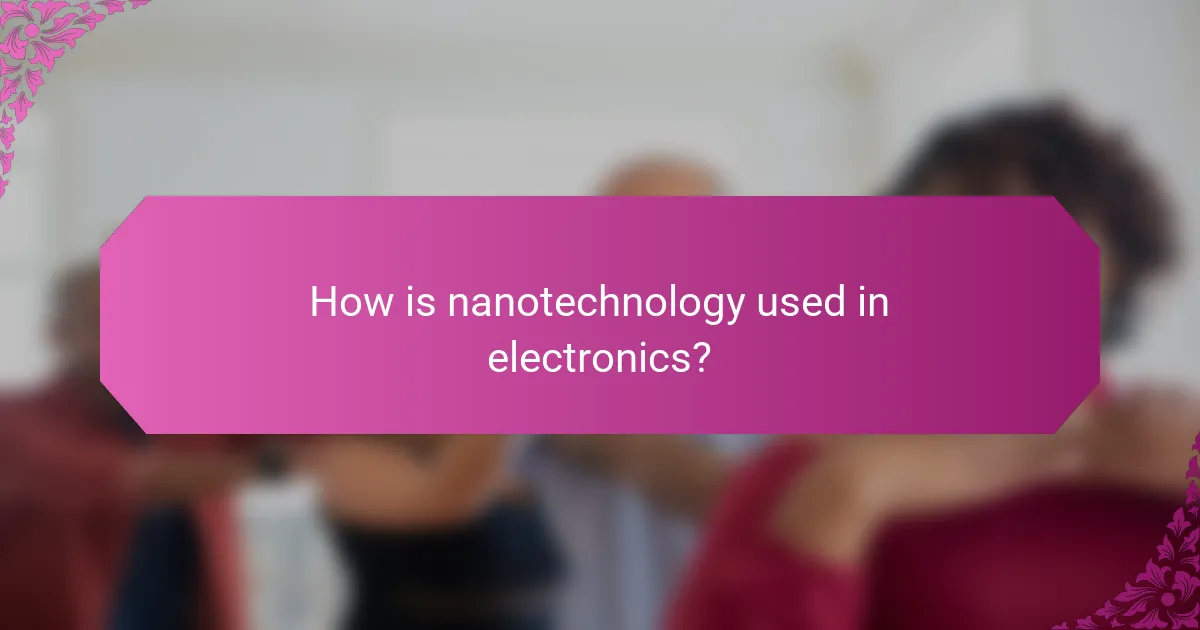
How is nanotechnology used in electronics?
Nanotechnology is utilized in electronics to enhance performance, efficiency, and functionality of devices. By manipulating materials at the nanoscale, manufacturers can create components that are faster, smaller, and more energy-efficient.
Nanoelectronics for faster devices
Nanoelectronics refers to electronic components that are designed and fabricated at the nanoscale. This technology allows for the miniaturization of transistors, enabling faster processing speeds and improved performance in devices such as smartphones and computers. For instance, transistors made from nanomaterials can switch on and off in picoseconds, significantly enhancing data processing capabilities.
Flexible displays
Nanotechnology has paved the way for flexible displays, which are lighter and more versatile than traditional screens. These displays utilize nanomaterials like organic light-emitting diodes (OLEDs) that can bend without losing functionality. This innovation is particularly useful in creating wearable devices and foldable smartphones, offering consumers more options in design and usability.
Quantum dots in displays
Quantum dots are nanoscale semiconductor particles that improve display technology by enhancing color accuracy and brightness. When integrated into screens, they can produce a wider color gamut and better energy efficiency compared to conventional displays. This technology is increasingly used in high-end televisions and monitors, providing users with a superior viewing experience.
Energy-efficient transistors
Transistors made with nanotechnology are designed to consume less power while maintaining high performance. These energy-efficient transistors can reduce the overall energy consumption of electronic devices, which is crucial for battery-operated gadgets. By implementing materials like graphene or carbon nanotubes, manufacturers can create transistors that operate at lower voltages, extending battery life and reducing heat generation.

What are the benefits of nanotechnology in environmental applications?
Nanotechnology offers significant benefits in environmental applications by enhancing the efficiency and effectiveness of processes like water purification, pollution control, and soil remediation. These innovations can lead to cleaner ecosystems and improved public health outcomes.
Water purification systems
Nanotechnology improves water purification systems by utilizing nanomaterials that can filter out contaminants at the molecular level. For instance, nanoparticles can effectively remove heavy metals, pathogens, and organic pollutants, making water safer for consumption.
Common methods include using carbon nanotubes and nanofilters, which can achieve higher filtration rates than traditional systems. These technologies not only enhance purification efficiency but also reduce energy consumption and operational costs.
Pollution control technologies
In pollution control, nanotechnology plays a crucial role in developing advanced materials that can capture and neutralize pollutants. Nanocatalysts, for example, can accelerate chemical reactions that break down harmful substances in the air and water.
These technologies can be integrated into existing systems, such as exhaust filters in vehicles or industrial emissions controls, significantly reducing the release of toxic compounds. This approach aligns with global environmental regulations aimed at minimizing pollution levels.
Soil remediation techniques
Nanotechnology enhances soil remediation techniques by using nanoparticles to target and degrade contaminants in the soil. This method is particularly effective for organic pollutants, heavy metals, and pesticides, which can persist in the environment for long periods.
Techniques such as phytoremediation, where plants are used alongside nanomaterials, can improve the uptake of contaminants, making the soil healthier. Implementing these solutions can lead to more sustainable agricultural practices and restore degraded land effectively.

What innovations are driving nanotechnology forward?
Innovations in nanotechnology are primarily driven by advancements in materials science, engineering, and biotechnology. Key developments include the creation of novel nanomaterials, enhanced manufacturing techniques, and applications in various fields such as medicine and electronics.
Graphene applications
Graphene, a single layer of carbon atoms arranged in a hexagonal lattice, is celebrated for its remarkable strength and conductivity. Its applications span from flexible electronics and high-capacity batteries to advanced composites and sensors. For instance, graphene-based materials are being explored for use in lightweight, durable sports equipment and energy-efficient devices.
In the field of medicine, graphene is being investigated for drug delivery systems and biosensors, where its high surface area and biocompatibility can enhance efficacy. The ongoing research aims to address scalability and cost-effectiveness to make these applications commercially viable.
Carbon nanotubes in materials science
Carbon nanotubes (CNTs) are cylindrical structures made of carbon atoms, known for their exceptional mechanical, electrical, and thermal properties. They are increasingly used in materials science to create stronger, lighter materials for aerospace, automotive, and construction industries. For example, incorporating CNTs into polymers can significantly enhance their tensile strength and thermal stability.
However, challenges remain in the uniformity and dispersion of carbon nanotubes within materials, which can affect performance. Researchers are focusing on improving manufacturing processes and developing better methods for integrating CNTs into existing materials to maximize their benefits.
Smart nanomaterials
Smart nanomaterials are engineered to respond to external stimuli such as temperature, pH, or light, making them versatile for various applications. These materials can change their properties or functions in response to environmental changes, which is particularly useful in drug delivery, where they can release therapeutic agents at targeted sites in the body.
Examples include nanoparticles that release drugs in response to specific biological signals or coatings that change color when exposed to certain conditions. The development of these materials is guided by the need for precision and control in applications ranging from healthcare to environmental monitoring.
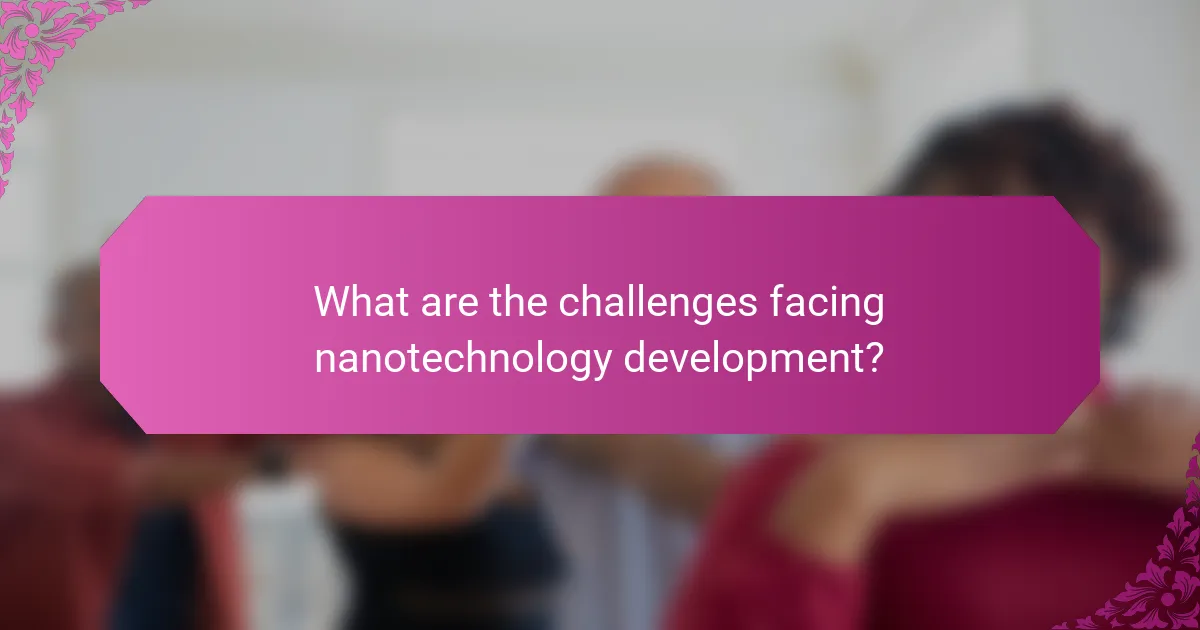
What are the challenges facing nanotechnology development?
Nanotechnology development faces several significant challenges, primarily in regulatory frameworks, public perception, and technical limitations. These hurdles can slow down innovation and commercialization of nanotechnology applications across various sectors.
Regulatory hurdles
Regulatory hurdles are a major challenge in the development of nanotechnology. Governments and regulatory bodies often lack specific guidelines tailored to the unique properties and risks associated with nanomaterials. This can lead to lengthy approval processes and uncertainty for companies looking to bring new nanotechnology products to market.
In many regions, including the European Union and the United States, existing regulations may not adequately address the safety and environmental impacts of nanomaterials. For instance, the REACH regulation in the EU requires extensive testing and data submission for new substances, which can be particularly burdensome for nanotechnology innovations.
To navigate these regulatory challenges, companies should engage with regulatory agencies early in the development process. Staying informed about evolving regulations and participating in industry groups can also help in shaping favorable policies for nanotechnology advancements.






